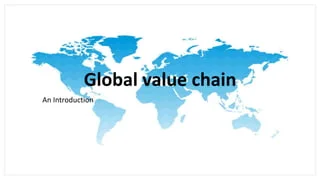Table of Contents

Why in news?
- NITI Aayog will unveil its highly anticipated report, “Electronics: Powering India’s Participation in Global Value Chains.”
- This report is the culmination of extensive analysis of India’s electronics sector, outlining the scopes and challenges while laying down a comprehensive roadmap for India to emerge as a global manufacturing hub in electronics.
- This blog will delve into the key insights and strategies from the report, highlighting India’s potential and necessary steps to enhance its participation in the Global Value Chain (GVC).
Global Value Chains and Their Significance
- Global Value Chains (GVCs) were defined as the internationalization of production activities where value adding activities can be undertaken in different countries.
- This current international trade structure has it that GVC items constitute about 70 percent of the entire global trade, thus explaining why countries must improve their engagement in Global Value Chains.
- These GVC sectors include electronics and IT, semiconductors, automobiles, chemicals, and pharmaceuticals that must remain strategic for India because of their important place in the contemporary Global Value Chains system.
The centrality of electronics in Global Value Chains
- There is high concentration of Global Value Chains in the electronics sector of which nearly 80% of electronics exports come from.
- Concerning thereby is stressing the sector’s importance and huge potential for further Indias’ contribution to the GVC. Sustaining the growth rate of this sector is stressed upon in this report by the NITI Aayog and to boost the competitiveness of this sector internationally.
Situation Analysis of Electronics Export in India
- It indicates that in the financial year 2023 India’s electronics sector achieved a glorious position by touching an appreciable value of exports and electronics sector accounts for 5% of the country’s GDP.
- Accounted for 32per cent of the total of merchandise exports of the country. This has established that this sector is among the most competitive in the global market and capable of satisfying global consumption needs, thus raising India’s status within the electronics market system.
Issues in Today’s Environment
- Nevertheless, the present export performance shows an encouraging picture about India’s electronics manufacturing business, the business primarily revolves in import of completely built electronics products.
- Design and brands prefer subcontracting assembly testing and packaging to EMI, which are also called Electronic Manufacturing Services companies in India.
- However, the ecosystem for designing and manufacturing of components of the sophisticated products has not evolved to-date.
- The absence of an enabling environment to foster a backward integration is an important factor that needs to be filled to ensure India goes from assembling electronics to manufacturing electronics products fully.
Strategic Framework on how to improve Kenya’s GVC Participation
- The report of NITI Aayog pertains to the aspirations and laid down the strategies of the Indian government to transform the country into a manufacturing hub in electronics sector.
- The report suggests several strategic measures to achieve this goal:The report suggests several strategic measures to achieve this goal:
Boosting the Electronics Manufacturing Industry Cluster
- Incentivizing Design and Component Manufacturing:
- Promoting the investments in design and manufacturing of components to minimize import quotient as well as strengthening home-grown ecosystem.
- Enhancing EMS Capabilities:
- Promoting the expansion of EMS companies through acting on the policy, infrastructure enhancements and adopting appropriate technologies.
- Skill Development:
- Targeting skill development programs to build a pool of human capital which would be adequate to accommodate complex manufacturing strategies.
policy interventional and infrastructure development.
- Policy Reforms:
- Establishing programs, enacting reforms and ensuring policy changes for the development of better business climate, foreign direct investment and domestic entrepreneurship.
- Infrastructure Upgradation:
- The development of infrastructure particularly in logistics and transportation system, industrial parks, factories, etc for mass production.
- Promoting Research and Development
- R&D Investments: Continuous improvement of the amount allocated to research and development in an effort to enhance new products, production techniques, and other technologies.
- Collaboration with Global Firms: Promoting partnerships between Indian firms and international software houses, in an effort to create a system of learning that will ensure positive technological development.
Conclusion
- Having noted this, the manufacturing sector will be central to India’s journey towards Viksit Bharat: the envisioned developed India.
- The initiative of Make-in-India needs to be scaled up further and this can be done by deep engagement in Global Value Chains.
- The report of the NITI Aayog acts as a map in a sense providing points that can be implemented for transforming the electronics sector in India and thus make the country a hub for manufacturing electronics.
- As highlighted by this report, it is possible for the GVC participation of India to be greatly improved, thus encouraging economic growth and new technologies through the aforementioned strategies.
- The mentioned report “The Electronics Manufacturing Sector in India: Creating the Foundation to Power India’s Participation in Global Value Chains” published for NITI Aayog defines the priority of electronics and offers directions to the Indian government for achieving the manufacturing vision.
- The findings of the report contain many recommendations and strategies that are critical for India to become a hub for electronics manufacturing.
FAQS
Q1: What is the significance of the report?
Ans: The report provides a comprehensive analysis of India’s electronics sector, outlining its scopes, challenges, and a roadmap for becoming a global manufacturing hub.
Q2: Why is participation in Global Value Chains (GVC) important for India?
Ans: Global Value Chains participation is crucial because 70% of international trade comprises GVC items. Enhancing India’s participation can boost its economic growth and global competitiveness.
Q3: Which sectors are prioritized for GVC participation in the report?
Ans: The prioritized sectors include electronics, semiconductors, automobiles, chemicals, and pharmaceuticals.
Your article helped me a lot, is there any more related content? Thanks!
I don’t think the title of your article matches the content lol. Just kidding, mainly because I had some doubts after reading the article.